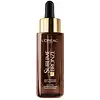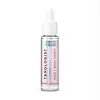What's inside
What's inside
 Key Ingredients
Key Ingredients

 Benefits
Benefits

 Concerns
Concerns

No concerns
 Ingredients Side-by-side
Ingredients Side-by-side

Water
Skin ConditioningDihydroxyacetone
Skin ConditioningAlcohol Denat.
AntimicrobialGlycerin
HumectantXanthan Gum
EmulsifyingHydrolyzed Soybean Fiber
Skin ProtectingCommiphora Mukul Resin Extract
Skin ConditioningColeus Forskohlii Root Extract
EmollientTocopheryl Acetate
AntioxidantAscorbic Acid
AntioxidantErythrulose
TanningPanthenol
Skin ConditioningAloe Barbadensis Extract
Skin ConditioningCalendula Officinalis Flower Oil
MaskingCitrus Paradisi Fruit Extract
Skin ConditioningJuniperus Communis Fruit Oil
MaskingLycium Barbarum Fruit Extract
AstringentPunica Granatum Extract
AstringentPolysorbate 80
EmulsifyingDipropylene Glycol
HumectantTriethylene Glycol
MaskingEthylhexylglycerin
Skin ConditioningSodium Metabisulfite
AntioxidantParfum
MaskingHexyl Cinnamal
PerfumingLimonene
PerfumingLinalool
PerfumingGeraniol
PerfumingSodium Hydroxide
BufferingPhenoxyethanol
PreservativeWater, Dihydroxyacetone, Alcohol Denat., Glycerin, Xanthan Gum, Hydrolyzed Soybean Fiber, Commiphora Mukul Resin Extract, Coleus Forskohlii Root Extract, Tocopheryl Acetate, Ascorbic Acid, Erythrulose, Panthenol, Aloe Barbadensis Extract, Calendula Officinalis Flower Oil, Citrus Paradisi Fruit Extract, Juniperus Communis Fruit Oil, Lycium Barbarum Fruit Extract, Punica Granatum Extract, Polysorbate 80, Dipropylene Glycol, Triethylene Glycol, Ethylhexylglycerin, Sodium Metabisulfite, Parfum, Hexyl Cinnamal, Limonene, Linalool, Geraniol, Sodium Hydroxide, Phenoxyethanol
 Reviews
Reviews

Ingredients Explained
These ingredients are found in both products.
Ingredients higher up in an ingredient list are typically present in a larger amount.
Dihydroxyacetone, or DHA, is a simple sugar. It is frequently used in self-tanning products.
DHA binds to the amino acids in your dead skin cells to create a brown/orange color. Darkening begins to kick in a few hours after application and will continue to develop for up to 3 days. This ingredient can be drying.
Both the US and the EU have approved DHA in self-tanning products. In the EU, DHA is allowed at a maximum concentration of 10%. Most tanning products usually contain amounts between 3-5%.
If you are pregnant or have underlying medical conditions, it is best to speak with a dermatologist about using self-tanning products.
Learn more about DihydroxyacetoneGlycerin is already naturally found in your skin. It helps moisturize and protect your skin.
A study from 2016 found glycerin to be more effective as a humectant than AHAs and hyaluronic acid.
As a humectant, it helps the skin stay hydrated by pulling moisture to your skin. The low molecular weight of glycerin allows it to pull moisture into the deeper layers of your skin.
Hydrated skin improves your skin barrier; Your skin barrier helps protect against irritants and bacteria.
Glycerin has also been found to have antimicrobial and antiviral properties. Due to these properties, glycerin is often used in wound and burn treatments.
In cosmetics, glycerin is usually derived from plants such as soybean or palm. However, it can also be sourced from animals, such as tallow or animal fat.
This ingredient is organic, colorless, odorless, and non-toxic.
Glycerin is the name for this ingredient in American English. British English uses Glycerol/Glycerine.
Learn more about GlycerinPhenoxyethanol is a preservative that has germicide, antimicrobial, and aromatic properties. Studies show that phenoxyethanol can prevent microbial growth. By itself, it has a scent that is similar to that of a rose.
It's often used in formulations along with Caprylyl Glycol to preserve the shelf life of products.
Water. It's the most common cosmetic ingredient of all. You'll usually see it at the top of ingredient lists, meaning that it makes up the largest part of the product.
So why is it so popular? Water most often acts as a solvent - this means that it helps dissolve other ingredients into the formulation.
You'll also recognize water as that liquid we all need to stay alive. If you see this, drink a glass of water. Stay hydrated!
Learn more about WaterXanthan gum is used as a stabilizer and thickener within cosmetic products. It helps give products a sticky, thick feeling - preventing them from being too runny.
On the technical side of things, xanthan gum is a polysaccharide - a combination consisting of multiple sugar molecules bonded together.
Xanthan gum is a pretty common and great ingredient. It is a natural, non-toxic, non-irritating ingredient that is also commonly used in food products.
Learn more about Xanthan Gum